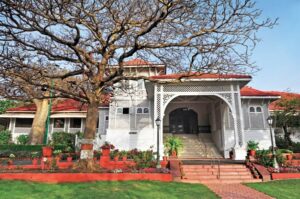

Governor Medows (1788 to 1790) had built a little ‘Hunting Lodge’ for resting from the heat of the afternoon sun when out on shikar on the hills. Governor Sir Evan Nepean(1812-1819) started living in this small lodge overnight. Then along came Governor Monstuart Elphinstone (1819-1827) with his grander plans for our city. He built the first ‘bungalow’ to reside in.
The ‘pretty cottage washed by the sea spray’ was adorned with French furniture, artistic wooden carpentry and exquisite paintings. These have received care over nearly 200 years, and can be seen even today in the present residence of the Governor.
1883 saw a decimation of the population of Bombay by the Great Plaque. Nature granted no special privileges to those in power, and Governor James Ferguson’s wife succumbed to this devastating illness. After this event Ferguson moved his residence to ‘the hillock’ and built a larger residence for the seat of power.
1883 saw a decimation of the population of Bombay by the Great Plaque. Nature granted no special privileges to those in power, and Governor James Ferguson’s wife succumbed to this devastating illness. After this event Ferguson moved his residence to ‘the hillock’ and built a larger residence for the seat of power.
He enlarged the little cottage to today’s ‘Jal Bhushan’ and marked out the 49 acres for exclusive use of subsequent Governors. In words of Pramila Phatarphekar, who scripted the booklet on the ‘Raj Bhavan’ in 1997, ‘the estate undulates from shore to land, witnessed by the firmament forest, cliff, sea and sand,’ Overlooking the ‘Queen’s Necklace’ several buildings were constructed for specific purposes. The ‘Point Bungalow’ became ‘Jal Chintan’, the favoured guest house of Pandit Jawaharlal Nehru; the Banquet Hall was renamed as ‘Jal Vihar’ and the Durbar Hall or “Jal Sabhagraha’ hosts official functions.


Development was also taking place in other areas. Infrastructure projects were carefully planned and executed. Water supply for an ever-growing population was a major issue. The Vihar Water Works Project was undertaken in 1860 and Malabar Hill, being the highest hill, was identified as the best location for a reservoir, from where water could be distributed. Two huge tanks were constructed and water-lines laid to the city below.
These two tanks, with slopes on both sides to the sea needed protection. It was decided ‘to cover the tanks from potentially contaminating droppings from the Towers of Silence located nearby.’ Ulhas Ghaporkar, a city engineer, was entrusted with the task of laying ‘the Hanging Gardens’ in 1881.These beautifully laid out gardens provided an area for outings, as the wild animals had all disappeared by then, and the population needed open space. The gardens were relaid in 1921 with unique topiary and renamed after Independence as the Pherozeshah Mehta Garden.
Man around the world has always carried his gods with him and built places of worship. So it was with our Malabar Hills. In 1881 the Government granted a piece of land near the reservoir & a sum of Rs. 5000/- for the construction of a small church attached to the main Cathedral in the Fort. It was opened on 16th January 1882 as the All Saints Church. A beautiful stone structure with a wooden bell turret. Unfortunately this turret was damaged by the cyclone that hit our city in 1948, and had to be removed in 1951 as it was considered ‘unsafe and irreparable’.1957 brought another change. It was created asa separate ecclesiastical parish of the Mumbai Diocese of the Church of North India.

Thereafter development on the Hills moved in leaps and bounds. Four-legged animals gave way to two-legged ones. Beautiful stone structures with verdant gardens disappeared. Today’s Malabar Hill & Cumballa Hill became home to the rich & powerful.
Anita Garware, Chairperson, INDIAN HEITAGE SOCIETY-MUMBAI – Resident of Malabar Hill





